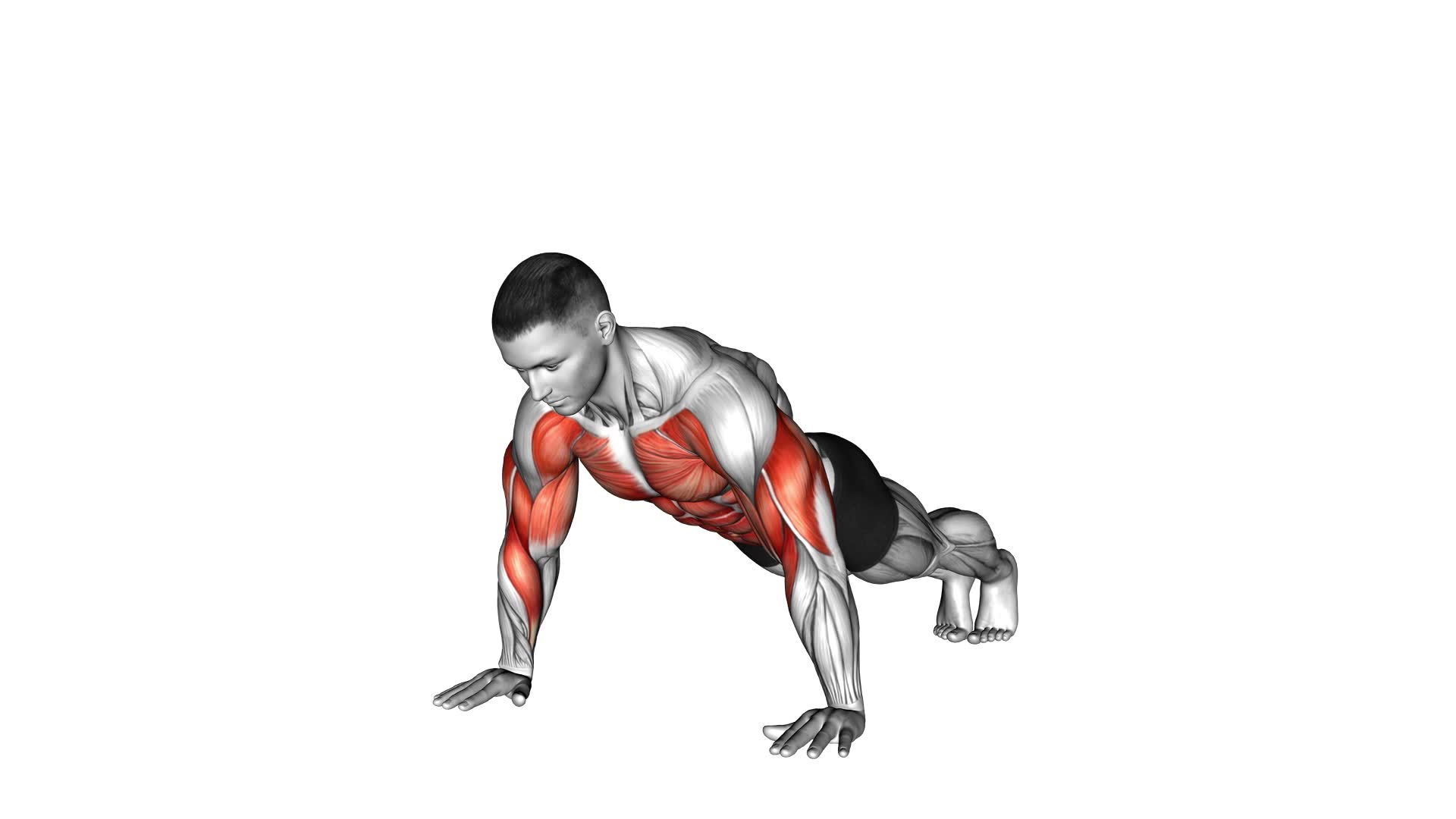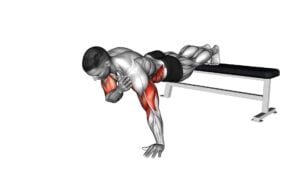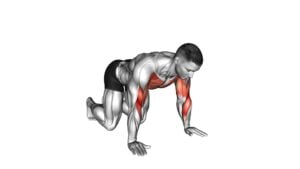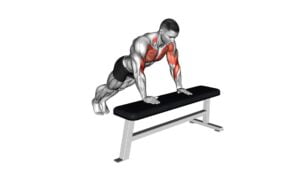Shoulder Tap – Video Exercise Guide & Tips

Looking to improve your stability and core strength? Look no further than the Shoulder Tap exercise.
Watch This Exercise Video
In this video exercise guide, we'll show you proper form and technique, variations and modifications, and common mistakes to avoid.
With the help of these tips, you'll be on your way to achieving better balance and a stronger core.
So grab a mat and get ready to tap into your full potential with Shoulder Tap!
Key Takeaways
- Shoulder tap exercise targets core and shoulder muscles, improving balance and stability.
- Proper form and technique include starting in a high plank position, maintaining a straight line from head to toe, engaging core muscles and squeezing glutes, and tapping each shoulder while stabilizing the core.
- Variations and modifications of the exercise include tapping opposite hip or thigh instead of shoulder, performing with one hand for advanced challenge, trying on unstable surfaces like BOSU ball or stability ball, and maintaining proper form and technique in all variations.
- Common mistakes to avoid during the shoulder tap exercise include improper alignment and arching of the back, inconsistent pacing, lack of core engagement, relying on momentum instead of core strength, and neglecting proper shoulder positioning and shrugging.
Benefits of Shoulder Tap Exercise
To maximize the effectiveness of your workout, it's important to understand the benefits that the Shoulder Tap exercise can provide. Shoulder tap progressions can be a great addition to your routine, as they target your core and shoulder muscles while also challenging your balance and stability. By incorporating shoulder taps into your workout, you can strengthen your core muscles, including your abdominals, obliques, and lower back.
This exercise also engages your shoulder muscles, specifically the deltoids and trapezius, helping to improve upper body strength and stability.
Shoulder tap challenges can vary depending on your fitness level and goals. For beginners, the challenge may lie in maintaining proper form and balance while tapping each shoulder. As you progress, you can increase the difficulty by performing the exercise in a plank position or adding a push-up between each tap. This not only adds an extra challenge for your core and shoulders, but also increases the overall intensity of the exercise.
Proper form and technique are essential when performing shoulder taps. It's important to maintain a strong plank position throughout the exercise, with your hands directly under your shoulders and your body in a straight line from head to toe. Avoid sagging or arching your back, and focus on engaging your core muscles to stabilize your body.
Proper Form and Technique
Maintain proper form and technique during the Shoulder Tap exercise by ensuring a strong plank position and engaging your core muscles. To perform the exercise correctly and maximize its benefits, follow these guidelines:
- Start in a high plank position with your hands shoulder-width apart and your wrists directly under your shoulders.
- Keep your body in a straight line from head to toe, avoiding any sagging or lifting of the hips.
- Engage your core muscles by pulling your belly button towards your spine and squeezing your glutes.
- Maintain a neutral spine by keeping your neck aligned with your back and avoiding any excessive arching or rounding.
- While maintaining a stable core, lift one hand off the ground and tap it on the opposite shoulder, alternating sides.
By practicing proper hand placement and improving balance, you can enhance the effectiveness of the Shoulder Tap exercise. Remember to distribute your weight evenly between your hands and avoid placing too much pressure on your wrists. Additionally, focus on maintaining a stable base by spreading your fingers wide and pressing through the entire hand.
With a solid foundation in proper form and technique, you can now explore variations and modifications to challenge yourself further in the Shoulder Tap exercise.
Variations and Modifications
Try incorporating these three variations to challenge yourself further in the Shoulder Tap exercise.
One way to modify the exercise is by changing the hand placements. Instead of tapping your opposite shoulder, try tapping your opposite hip or thigh. This variation engages different muscles in your core and adds an extra level of difficulty to the exercise.
Another advanced variation is to perform the Shoulder Tap exercise with one hand. Start in a high plank position and lift one hand off the ground to tap the opposite shoulder. This variation requires more stability and strength in your core and shoulders.
For an even greater challenge, you can try performing the Shoulder Tap exercise on an unstable surface, such as a BOSU ball or a stability ball. The instability of the surface forces your muscles to work harder to maintain balance and control.
Remember to maintain proper form and technique in all variations of the Shoulder Tap exercise. Keep your core engaged, shoulders stable, and avoid any excessive movement in your hips or lower back.
Incorporating these different hand placements and advanced variations can help you effectively target your core muscles and take your Shoulder Tap exercise to the next level.
Common Mistakes to Avoid
Avoiding these common mistakes will help you get the most out of the Shoulder Tap exercise. To ensure you're performing the exercise correctly and maximizing its benefits, be mindful of the following:
- Improper alignment: Keep your body in a straight line from head to toe. Avoid sagging or arching your back, as this can put unnecessary strain on your spine.
- Inconsistent pacing: Maintain a steady pace when tapping your shoulders. Avoid rushing or slowing down, as this can compromise the effectiveness of the exercise.
- Lack of core engagement: Engage your core muscles throughout the exercise to stabilize your body and prevent excessive movement.
- Relying on momentum: Avoid using momentum to lift your hand off the ground. Instead, focus on using your core strength to control the movement.
- Neglecting proper shoulder positioning: Keep your shoulders down and away from your ears. Avoid shrugging or hunching your shoulders, as this can lead to tension and discomfort.
Tips for Improving Stability and Core Strength
To enhance your stability and strengthen your core, consistently engage in exercises that target these areas. Improving balance is an essential component of stability training. Incorporating exercises such as single-leg stands, heel-to-toe walks, and yoga poses like tree pose can help improve your balance. These exercises challenge your body to maintain stability and improve proprioception, which is your body's awareness of its position in space.
In addition to improving balance, incorporating core exercises into your routine is crucial for building core strength. Exercises like planks, Russian twists, and bicycle crunches target the muscles in your abdomen, lower back, and pelvis, collectively known as the core. Building core strength not only improves stability but also enhances overall performance in daily activities and sports.
When performing core exercises, it's important to engage the muscles correctly. Focus on pulling your navel towards your spine to activate the deep abdominal muscles. Maintain proper form throughout the exercises and avoid overarching or rounding your lower back.
Consistency is key when it comes to improving stability and core strength. Aim to include balance and core exercises in your workout routine at least two to three times a week. As you progress, you can increase the duration or intensity of the exercises to continue challenging your stability and core muscles. Remember to listen to your body and consult with a fitness professional if you have any concerns or questions.
Frequently Asked Questions
How Many Calories Does the Shoulder Tap Exercise Burn?
The shoulder tap exercise is a great way to burn calories and improve your fitness. It engages your core muscles, helping to strengthen and tone them.
While the exact number of calories burned will vary depending on factors such as your weight and intensity of the exercise, the shoulder tap can be an effective calorie-burning exercise.
Incorporating this exercise into your routine can have numerous benefits, including improved stability, balance, and overall strength.
Can the Shoulder Tap Exercise Help Reduce Back Pain?
The shoulder tap exercise has several benefits that can help reduce back pain. By engaging your core and stabilizing your spine, this exercise can improve your posture and strengthen your back muscles.
To perform the shoulder tap exercise properly, start in a high plank position with your hands directly under your shoulders. Keep your body in a straight line and avoid any excessive movement or rotation.
Is It Better to Perform the Shoulder Tap Exercise on a Mat or on a Hard Surface?
It's important to consider whether you should perform the shoulder tap exercise on a mat or on a hard surface. Both options have their benefits.
Using a mat can provide extra cushioning and support for your wrists and shoulders, reducing the risk of injury.
On the other hand, performing the exercise on a hard surface can challenge your balance and stability, helping to strengthen your core muscles.
Ultimately, the choice depends on your personal preference and comfort level.
Can the Shoulder Tap Exercise Be Modified for Individuals With Wrist Injuries?
If you have a wrist injury and need to modify the shoulder tap exercise, there are alternative exercises you can try.
By avoiding putting weight on your injured wrist, you can still work your shoulders and core effectively.
For example, you can do plank shoulder taps using your forearms instead of your hands.
This will help alleviate strain on your wrists while still targeting the same muscle groups.
How Often Should the Shoulder Tap Exercise Be Performed for Optimal Results?
To achieve optimal results with the shoulder tap exercise, it's important to consider the frequency and variations.
When it comes to shoulder tap exercise frequency, it's recommended to perform it at least 2-3 times a week. This allows your muscles to recover while still challenging them.
Additionally, incorporating variations such as elevating your feet or using a stability ball can further enhance the effectiveness of the exercise.
Conclusion
In conclusion, the shoulder tap exercise is a great way to improve stability and core strength. By maintaining proper form and technique, you can effectively target your shoulders and engage your core muscles.
Remember to avoid common mistakes and consider variations or modifications to challenge yourself as you progress. Incorporating shoulder taps into your workout routine can provide numerous benefits, helping you achieve your fitness goals.

Author
Years ago, the spark of my life’s passion ignited in my mind the moment I stepped into the local gym for the first time. The inaugural bead of perspiration, the initial endeavor, the very first surge of endorphins, and a sense of pride that washed over me post-workout marked the beginning of my deep-seated interest in strength sports, fitness, and sports nutrition. This very curiosity blossomed rapidly into a profound fascination, propelling me to earn a Master’s degree in Physical Education from the Academy of Physical Education in Krakow, followed by a Sports Manager diploma from the Jagiellonian University. My journey of growth led me to gain more specialized qualifications, such as being a certified personal trainer with a focus on sports dietetics, a lifeguard, and an instructor for wellness and corrective gymnastics. Theoretical knowledge paired seamlessly with practical experience, reinforcing my belief that the transformation of individuals under my guidance was also a reflection of my personal growth. This belief holds true even today. Each day, I strive to push the boundaries and explore new realms. These realms gently elevate me to greater heights. The unique combination of passion for my field and the continuous quest for growth fuels my drive to break new ground.







